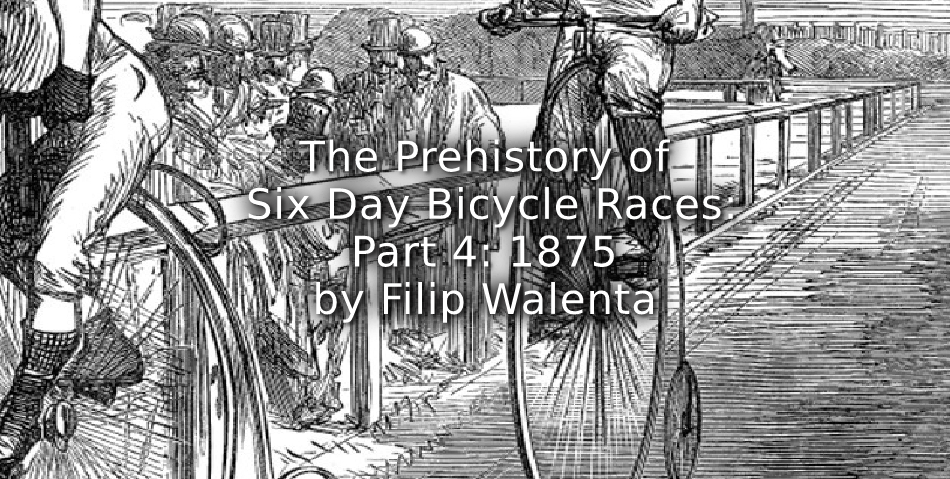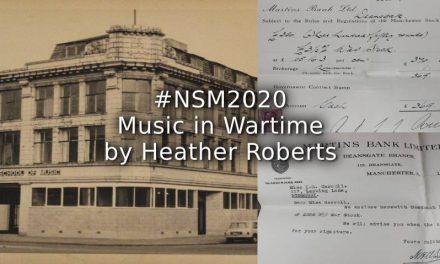To read Part 3 of this series – Click HERE
Introduction.
After the successful journey in October 1874 of the Hungarian hussar officer Theodore Count of Zubowitz, who rode from Vienna to Paris on one horse in fifteen days, and the unsuccessful attempt to ride from Pesth to Paris by the Austrian Paul Salvi in May 1875, the long-endurance sporting event had attracted the attention of the cycling world. [1]
As from the emergence of the draisine in the eighteen twenties and certainly the velocipede forty five years later there had always been a strong connection between the equestrian and cycling world. The supporters of the bicycle not only reflected the horse as a means of transport, but also as a sporting discipline. Consequently due to their parallel evolution there was always a certain kind of tension or rivalry between them. And according to de Saunier and Giffard, after the glorious year 1869 and four years of war and German occupation in Northern France, a new wind blew in the cycling world in 1875. It was the year of the discovery of the three forever undisputed glories of cycling: cycling tourism, cycling sport as an art form of doctrine and training, and the bicycle as a military application. [2]
The first Tour de France planned in 1875 (?)
Inspired by Zubowitz’s journey from Vienna to Paris on horseback the year before, in January 1875 Emile Houberdon, a forester and insurance agent from (Val de) Briey near the German border in the northeastern parts of France, wrote the following letter to the local newspaper Le Progrès de l’Est:
“The Hungarian officer Zubowitz covered, in fifteen days, with his mare Caradoc the distance from Vienna to Paris, that is to say approximately 1,500 kilometers, which gives an average of 93 kilometers per day. Also wishing to enter the fight, I am ready to cover, with my velocipede the Lucifer, a distance of 1,500 kilometers in 15 times twenty-four hours, which is 100 kilometers a day. The price of this race is fixed at 50,000 francs.
Please accept, Sir, the assurance of my respect. Houberdon.” [3]
Likely to get no response to his proposal, he repeated his appeal in September after several other cycling races over the course of the year. Houberdon had planned to start his trip in his home town Briey and intended, before finishing in Paris, to cross successively the cities of Lyon, Thiers, Clermont, Bourganeuf, Limoges, Château-Roux, Tours, Le Mans, Laval, Rennes, Saint-Malo, Alençon and Rouen.
As mentioned in Houberdon’s letter, the betting money to get the organization financed was set at fifty thousand francs, of which Houberdon himself took a share of five thousand francs. [4] The sum was probably never collected as no further information is provided.
But what if the race had ever been run, could it be considered the precursor to the Tour de France? Regardless, further investigation into this matter is recommended, not only to answer the previous question but also to find out to what extent Houberdon’s trajectory was used as an example or inspired the organizers of the first Tour for cars in 1899 or for bicycles in 1903.
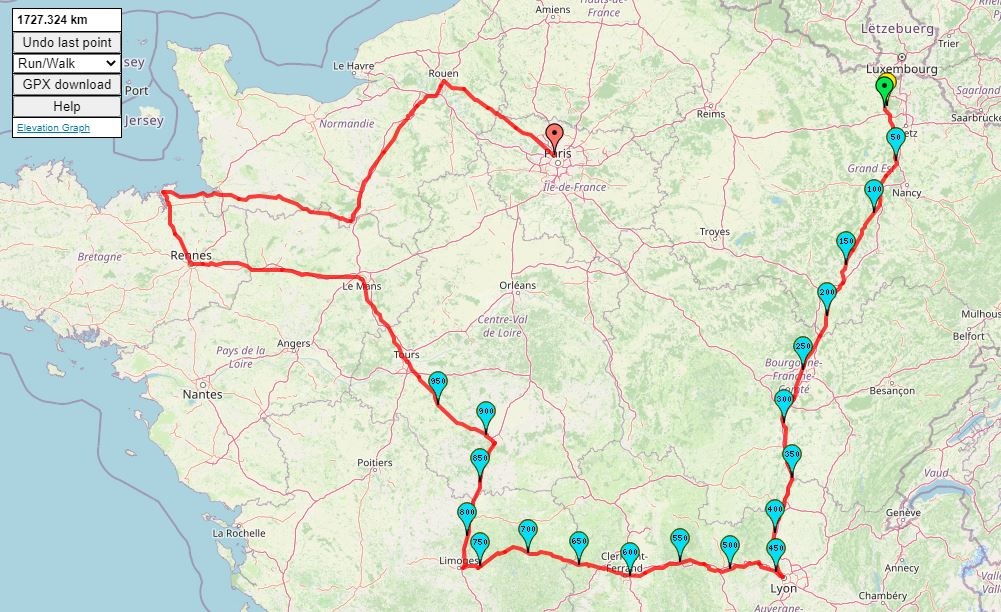
The planned route Briey-Paris of ca. 1700 kilometers [5]
Charles W. Nairn, an engineer born in Northumberland in 1844 and living in Fulham was a member of the London Bicycle Club. [6] On Saturday morning, August 14 1875, he left the British capital and travelled via Paris to Vienna. [7] First he had considered travelling the European continent by bicycle during his holiday. But later he got the idea to make a journey from Vienna to Paris and break Zubowitz’s record time by travelling eleven or twelve days. It would not be his first cycling feat, as previously Nairn successfully rode from London to Carlisle in twelve days. [8] Especially for the ride, the Coventry Machinists Company provided a penny-farthing weighing forty five pounds with a fifty-one inch front wheel. [9] To avoid the summer heat, he decided to ride five or six hours during the morning and two-three hours in the evening. [10]
After a test drive the day before at the Prater Park, Nairn started his race in front of the hotel Metropole in the center of the city of Vienna on Thursday August 19, at four o’clock in the morning. [11] Already after sixteen miles driving while crossing Pressbaum he found out that the axis of his front wheel was broken. [12] In Sankt Polten he was unable to find a blacksmith skilled enough to repair the damage. So finally on Friday afternoon in Melk, a small city along the banks of the Danube and only fifty-five miles away from Vienna, he realized he had no other choice then to abandon the race and to continue the journey by train. [13] Although he believed that the roads were easily drivable, he was convinced that his bicycle must have been damaged during its transfer from London to Vienna. [14]
Nairn arrived in the railway station of Paris on Monday, August 23, while the day after his compatriot and long-distance natationist Captain Matthew Webb successfully crossed the Channel and set food on the French coast on Wednesday morning after a twenty-one hour swim. [15]
Anyway, Nairn’s journey must have inspired other cyclists, including the French champion Thuillet Camille. End of August he declared in the press that he would ride from Vienna to Paris and hoped to clear the job only in seven days. [16] For the right equipment he relied on a bicycle constructed by his colleague and friend, the English champion John Keen. [17] Unfortunately his resolution would stop at empty words.
A second attempt to ride from Paris to Vienna, i.e. the opposite direction of Zubowitz’ ride, was made by two Frenchmen, Albert Laumaillé and Henri Pagis in October 1875. Pagis was the club secretary of the Vélo-Sport de Paris and Laumaillé represented the Véloce Club d’Angers. [18] They were accompanied by William J.B. Saunders, a journalist from the London newspaper Morning Advertiser, who followed the two men on their journey by train as a controlling referee and a logistics supervisor who looked for a place to eat and stay overnight. [19]
On Tuesday, October 12, 1875, at eight o’clock in the morning the two Frenchmen started their trip at the Place du Chateau d’Eau in Paris on their ‘Gentlemen Bicycles’ constructed by the Coventry Machinists Company. [20] The first week they traveled successively to Provins, Vitry-le-François, Toul, Saverne, Peresthal (Baden) and Reutlingen. [21] On Monday October 18, the bad weather forced them to stay in Ülm, and also on Tuesday they had to stay the overnight in Augsburg after a tiring day on muddy roads and steep hills. [22] On Thursday Laumaillé and Pagis left Munich early in the morning and arrived in Haag near the Austrian border. On Friday they were met by Vienna cyclists who accompanied them to Ried and Linz the day after. [23] Unfortunately on Sunday October 24, the last stage on their journey, Pagis’ bicycle broke down at twenty three kilometers away from the finish line. Laumaillé left his travel companion behind and arrived after a trip of twelve days and ten hours in the Austrian capital. Pagis arrived the day after by train.
According to Baudry de Saunier cycling tourism was born with the journey of Laumaillé and Pagis. [24]
The two men had the idea to push their record to nine days in May or June 1876 when the roads would be in better condition. [25]
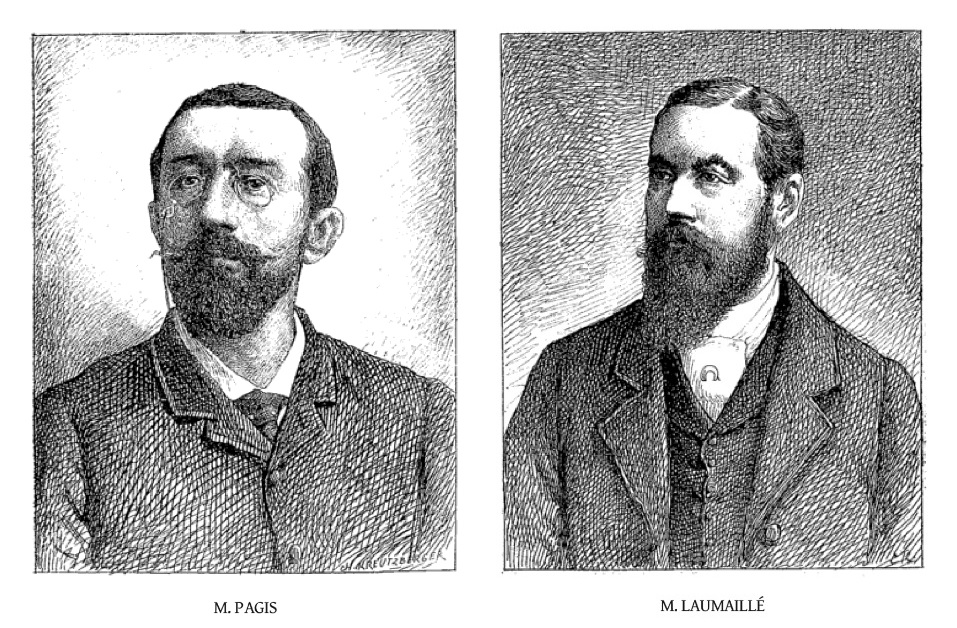
Henri Richard Pagis and Albert Laumaillé [26]
Since the end of the French-Prussian war the young ‘velocipede corporal’, as he was called, occupied an administrative post in the archives of the War Office, the former Ministry of Defense. Most probably he did not have access to classified documents, if not he could have faced the death penalty on the accusation of espionage. Nevertheless his thoughtless decision was irresponsible and reckless, which could have brought him into serious trouble.
Two weeks later on December 11, Pagis appeared before the war crimes tribunal in Paris on charges of desertion. Fortunately the court-martial was very lenient, as it did not consider the desertion intentional. Consequently Pagis received a disciplinary sentence, and instead of continuing his easy job in the War Office he was send to a combat regiment. [29]
In July 1886, the record was broken by Johann Fortner, a member of the Weener Turner Bicycle Club, who drove from Vienna to Paris in eleven days. [30] However, another eight years later in April 1894 it was smashed twice. First the Austrian Felix Adolf Schmal, 1896 Olympic gold medalist twelve-hour race, drove from Vienna to Paris in five days and fourteen hours and three weeks later the French Eduard de Perrodil cycled the other way around in six days and nine hours. [31][32]
David Stanton
David Stanton, born in Builth (Brecknockshire, Wales) in 1844 and proprietor of the Blenheims Arms pub in Hornsey (London) started his cycling career during the early eighteen seventies. [33] In 1874 he turned professional and specialized with varying degrees of success in long-endurance time trial races of fifty and one hundred miles.
At five o’clock in the morning on Monday, August 17, 1874, Stanton started the hundred and six mile feat between Bath and Kensington (London) in eight and a half hours for the bet of one hundred pounds. Although he lost a lot of time after colliding with a carriage, hurt his left shoulder and could only drive with his right hand, he was able to finish the ride with two minutes left. [34]
A month later on Saturday, September 19, he tried to sharpen the record by half an hour for a purse of two hundred pounds, but failed. Not only he had been run over by a startled horse, but he was also half beaten up and his bicycle damaged by a gang of four thugs in the region of Colnbrook at fifteen miles away from Kensington. In Colnbrook Stanton could continue his journey with another bicycle but he reached the finish line nearly one hour later then planned and lost the wager. Hearing the assailants talking about him just before the attack, he suspected they were probably hired by fraudulent bookmakers or bettors preventing him to win the contest. Stanton stated that he did not want to risk his life anymore and had decided to stop racing long-distance contests on turnpike roads. From then on he focused more on similar long-endurance feats on safer enclosed grounds such as the athletic and horse racing tracks. [35] Already two weeks later he started his first alternative Bath-London race over the same distance of one hundred and six miles at the Lillie Bridge Athletic Grounds in West Brompton (London), where the second FA-Cup had been contested the year before. [36][37] And within the year many similar other races followed on different sporting grounds (see table).
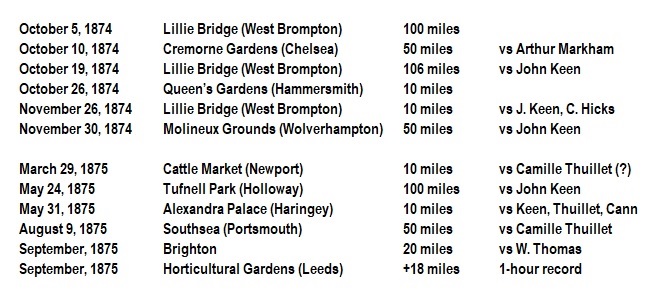
Long-endurance bicycle races in closed circuits by Stanton from October 1874 till October 1875. [38]
In September 1875, David Stanton announced that he would make the journey from Vienna to Paris in nine days and challenged everyone to take part in the competition. [39] He also declared to ride on a later date the same distance between the two capitals at the Lillie Bridge Grounds in seven days. [40] The first assignment was canceled, probably by lack of preparation (time) or sponsor money. It is also possible that he never intended to ride from Vienna to Paris as he previously had decided to race only on enclosed circuits. Maybe he just wanted to put his endeavour on the same level of the road race and as a consequence attract more (international) attention (read: more revenue on sponsoring and bets), just like he did with the Bath-London race.
Anyway, on Tuesday, October 26, 1875, two days after Laumaillé’s arrival in Vienna, David Stanton undertook his toughest long-endurance feat ever for a wager of one hundred pounds. At seven o’clock in the morning he commenced the race of six hundred and fifty miles in seven consecutive days in West Brompton. [41] Each of the seven days consisted of a racing time window of twelve hours, from six o’clock in the morning till six in the evening, but Stanton rarely commenced until seven and regularly left the Lillie Bridge Grounds short after five. The first six days he rode an average distance of ninety-five miles per day, leaving eighty-seven miles for the last day. On Sunday Stanton became unwell due to lack of sleep he suffered from during throughout the whole period, and it seemed he would not be able to complete his assignment. [42] But on Monday, the last day of the race, he was mentally assisted and accompanied by several colleague cyclists among which John Keen, the French champion Camille Thuillet and the Irish champion E. Tyler, who were apparently able to revive him.
In the afternoon about a quarter to five he finished his six hundred and fiftieth mile by the cheering of a considerable amount of spectators and won the contest with one hour and twelve minutes to spare. [43]
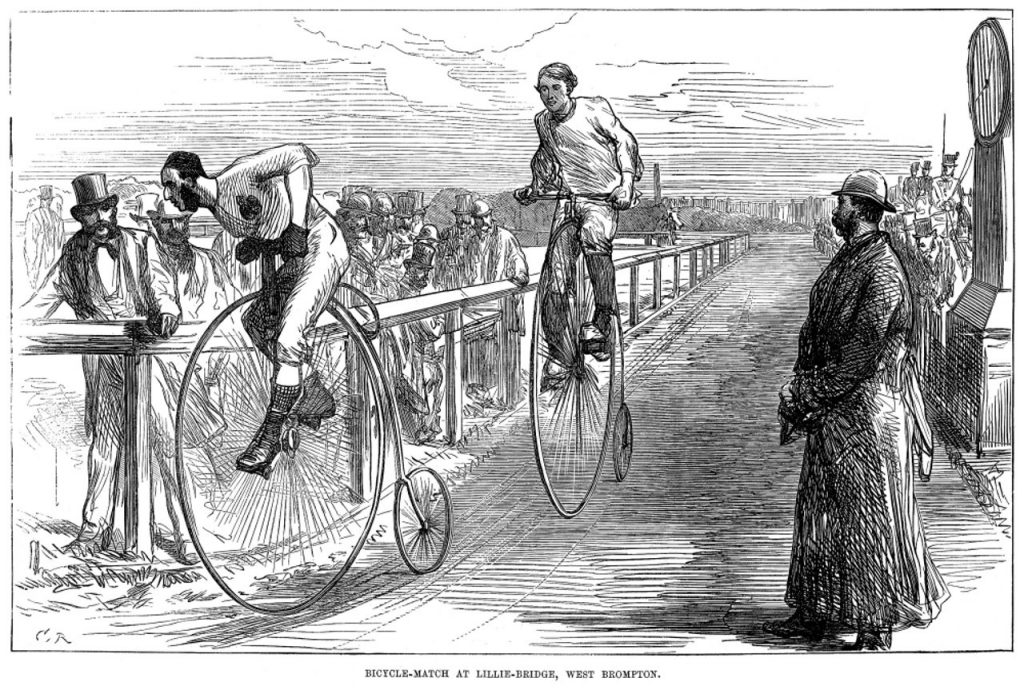
Bicycle-match in January 1875 at the Lillie Bridge Grounds, West Brompton. [44]
Conclusion
In 1875 the horse race from Vienna to Paris became de latest challenge in long-distance cycling. It gave the bicycle manufacturers the opportunity to prove that their machines were as practical, reliable and durable as a horse. The bicycle not only acquired a bigger share as a means of transport, but also as a means of tourist travel.
In sportshistorical perspective, in 1874 David Stanton was the first cyclist to project the track of a city-to-city race onto a sports field and can be considered as the initiator of long-distance cycling races in closed circuits. As a consequence he is also responsible for the introduction and emergence of cycling endurance competitions as a spectator sport.
Just like the variety halls and skating rinks during the (six-day) pedestrian races in the Northeastern parts of the US, the sports and horse racing tracks offered many advantages for the athletes. Next to increasing revenue of catering and gambling, the infrastructure ensured that their sporting achievements were able to continue in the best of circumstances. Interestingly, there were also other reasons, like avoiding bad road conditions, hilly trails and any form of aggression from angry locals, fraudulent bettors or bookmakers.
Stanton repeated a year later the concept with the former Paris-Vienna horse race. He used the distance between the two capitals of six hundred and fifty miles as the reference distance for his seven-day race.
In the final part 5 of the series Prehistory of the six-day bicycle races we will investigate the arrival of the pedestrian Edward Payson Weston in the UK and the emergence of the first six-day bicycle races in 1876.
Article 2022 @ Filip Walenta
References
[1] Walenta, Filip, The Equestrian Prehistory of Six Day Cycling Races (1874-1875). https://www.playingpasts.co.uk/articles/archival-research/the-equestrian-prehistory-of-six-day-cycling-races-part-3-1874-1875/.
[2] Louis Baudry de Saunier, Pierre Giffard, Le Cyclisme théorique et pratique (Paris, 1893), 57.
[3] Le Jockey, January 9, 1875, 3.
[4] Gazette de Lorraine, September 26, 1875, 3.
[5] Map Pedometer – How far did you go? <https://mappedometer.com>.
[6] Household of Charles W Nairn (born 1844, Northumberland), Find my Past. <https://www.findmypast.ie/1881-census/charles-w-nairn-0000311190> (Accessed December 10, 2022).
[7] The County Observer, August 21, 1875, 2.
[8] Die Presse, August 18, 1875, 9.
[9] The County Observer, August 21, 1875, 2; The Bicycle Journal, February 22, 1878, 91-92.
[10] l’Evénement, August 19, 1875, 2; Het Handelsblad, August 20, 1875, 2.
[11] Illustrirtes Wiener Extrablatt, August 20, 1875, 4; Le Temps, August 23, 1875, 3.
[12] Linzer Volksblatt, August 26, 1875, 3.
[13] Die Presse, August 24, 1875, 9.
[14] The Pembrokeshire Herald, August 27, 1875, 2.
[15] Le Figaro, August 25, 1875, 2.
[16] South Wales Daily News, August 28, 1875, 7.
[17] L’Evénement, August 27, 1875, 3.
[18] Louis Baudry de Saunier, Histoire générale de la vélocipédie (Paris 1891) 134-137.
[19] Grazer Zeitung, October 17, 1875, 4.
[20] Louis Baudry de Saunier, Histoire générale de la vélocipédie (Paris 1891) 134-137; Jagd-Zeitung, October 30, 1875, 26-27.
[21] Grazer Zeitung, October 27, 1875, 4; (Neuigkeits) Welt Blatt, October 21, 1875, 3.
[22] Le Courier d’Angers, October 29, 3-4.
[23] Affiches de Strasbourg, October 30, 1875, 2-3.
[24] Baudry de Saunier, Louis and Pierre Giffard, Le Cyclisme théorique et pratique (Paris, 1893), 57-58.
[25] Louis Baudry de Saunier, Histoire générale de la vélocipédie (Paris 1891), 137.
[26] l’Echo du Parlement, November 5, 1875, 1; Le Courrier d’Angers, November 13, 1875, 3.
[27] After the Treaty of Frankfurt in 1871 the Northern parts of France remained occupied by German troupes until Spring 1874 to ensure their five billion franc war indemnity.
[28] Le Guetteur de Saint-Quentin et de l’Aisne, November 28, 1875, 2.
[29] Le Petit Journal, December 13, 1875, 2.
[30] Prager Tagblatt, July 25, 1886, 6; Wiener Allgemeine Zeitung, July 21, 1886, 6.
[31] Adolf Schmall, Wikipedia, The Free Encyclopedia.
<https://en.wikipedia.org/wiki/Adolf_Schmal> (Accessed December 12, 2022).
[32] Le Radical, April 9, 1894, 3; Le Voltaire, May 2, 1894, 3.
[33] The Monmouthshire Merlin, September 25, 1874, 6; The Western Mail, November 7, 1874, 7.
[34] The Flintshire Observer, August 21, 1874, 3; The Pembrokeshire Herald, August 21, 1874, 2.
[35] The Western Mail, September 22, 1874, 8; The Monmouthshire Merlin, September 25, 1874, 6.
[36] The Western Mail, October 6, 1874, 8.
[37] Lillie Bridge Grounds, Wikipedia, The Free Encyclopedia, <https://en.wikipedia.org/wiki/Lillie_Bridge_Grounds> (Accessed August 18, 2022).
[38] Welsh Newspapers, The National Library of Wales.
<https://newspapers.library.wales/> (Accessed August 20, 2022).
[39] Neues Fremden-Blatt, September 28, 1875, 10.
[40] The Hour, September 18, 1875, 5.
[41] The Glasgow Herald, October 28, 1875, 5.
[42] The Week’s News (London), November 6, 1875, 13.
[43] The Hour, November 2, 1875, 6.
[44] The Illustrated London News, January 30, 1875.
[45] The Lancaster Gazette, November 13, 1875, 11.

